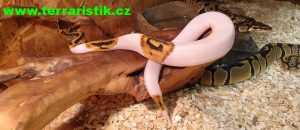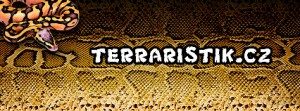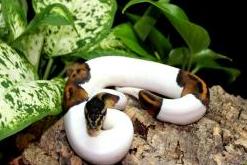Join us on Facebook



It is no secret, many breeders have only one goal and that is the profit they make. Genetics seems to be totally uninteresting. Everything has to be fast to quickly produce offspring. Imagine more than all breeding rules, commit incest, note any genetic defects, and easy to breed it happening. If an animal is pregnant and lays its eggs, the incubator is set high enough to exceeding the normal temperatures. The normal incubation temperature is 31 ° C to 31.5 ° C …. smallest swings are not so tragic and slip do it then so, after about 60 days. Through a higher temperature during incubation, the little ones can slip a few days earlier. The is dangerous because the hatchlings may have health problems, or are severely deformed, have no eyes or not viable. Who breeds so is very negligent and irresponsible. Still to come, it is an absolute mess when such animals are then sold and / or is thus further grown. recently I was approached by a man and asked if they can have Königspython descendants as with dogs. At first I thought it fun then he showed me pictures, not so good quality but you could tell that this Piebald male in the picture had a much longer maxilla and had by a similarity with a shark. The man wanted a piebald and drove it through the Czech Republic to a South Bohemian district. He took over the male, he has he seen the home which is not true. He had thought that grows the Piebald and it escaped. The seller of the animal assuring him that he would be absolutely healthy and gave him still writing. I advised him to reclaim the animal, because it was not right, because of this disease, which are never cured kann.Er should probably have been punished and the Office was also modest as it is ultimately considered, I can not say but it to show that it is not so. So should not be bred, not at the expense of animals.Den name of the breeder I know and to inquiry for why, it was only he did not know.

The normal breeding process at a breed is listed in various phases and timings. It is also so that it exactly runs on most snakes + – a few days. Nervous is one, if this predetermined times are exceeded by the animal. I myself had an experience in my breed entirely up to date with my Black Pastel females. Everything went quite well, even with the pairing, then came ovulation. After the normal period came molting. I began to count, because of egg laying. It was also nice and round and came as the time of ovulation, they do not put, but went back to the molting. So this was not the normal running and I was nervous. From the day of ovulation until Dato there were 70 days. I contacted Dr. Cermakova, from tirärztlichen University in Brno and made an appointment for inspection. It would have also to be an egg binding or other problem. It has been examined and ultrasound, it was all fine. The eggs need a little time to mature. On Monday 77 days after ovulation, I found my females to lay their eggs lying. It was a large nest with 11 eggs, which were unfortunately stuck already firmly together. I had to convert the whole nest together in the incubator. I am now looking for experience of other breeders. So I can compare, or find out why this was so.

A breeder sent me a photo from the breeding of a friend who has been advised by an alleged specialist in matters python, the eggs only at 28 ° C to incubate. That would be enough and one could with this temperature the same success. Unfortunately, this baby is dead and a second badly damaged, the third baby you see in the picture and you have probably nothing to schreiben.Jetzt the temperature should increase slowly in the incubator he werden.Ob approaches that do not know you. It can not as low to incubating be just as bad, it is too hot at 32 ° C to incubate or even higher. This image must be shown for more new young breeders are at the beginning.

Open this page because is one of my saddest stories. If I could, I would prove what I write here because it is so incredibly sound and something bad at all possible ist..Für what some do to animals, these are the Srafen not high genug.Es are breeders some horror stories. Some are programmable and have a real basis, some because you only get alongside news and stories from a breeder who bred his strong X-rays exposed before selling it. To make the special offspring infertile to stay only breeders of these animals. It tells a lot about, but unfortunately there is notangible evidence tangible. I laste only someone evil things that I can prove myself and prove. The only thing I’ll still sidelined is the name of the breeder. It relates to a breeder, with whom I worked together. We met a long time repeatedly so shortly before the end of the month in Austria. He wanted his breeding ad and offered it for sale. Among other things, a magnificent and beautiful subadult 0.1 python Black Pastel Piebald. The price was ok, but I could not decide. Eventually, he said, which has sold this animal. But then came an unexpected message, which has not paid for this animal, the buyer and this snake file now is for sale. The condition was only that it should go quickly. I got a very good discount and it had to go fast, was not a problem and so I drove soon happy with this beautiful animal home. When I fed them the first time they ate and one you saw anything that went bad it somehow her. About 8 weeks later I found her dead in the terrarium. It was a big shock for me and a personal tragedy. I took them and put them in the refrigerator in order to then immediately to the Veterinary University Hospital Brno brought. On the second day I got the autopsy results and it was another shock. The female, had the entire colon full of litter (wood chips), see photo. No snake could swallow much litter unless simultaneously with the rodent. It has made someone a lot of effort to cut open a rat, to fill them with bedding and sew up again. When the animal then swallows this rat, it is their certain death sentence. I do not know which bank has done, nor why. The assertion of the previous owner was, he did the animals always himself fed. Strangely it is only now, why suddenly the snake for half price and as quickly as possible, because then it is no longer difficult to guess who killed them. raises only the question WHY? Possibility is still that the first interested party wanted revenge because he had to return this animal because no payment. Sadly, that has paid this magnificent animal with his life only because of lousy machinations of a very primitive people. So much for this sad story, I make photo and medical report in.
Stay me only sad memories and the question, Why did she so cruel die?
Also deshlb I fight against animal cruelty and lousy machinations of animals with great determination.

Try a new display option! You and everyone else can share every display on our terraristic-portal with one click on facebook. Those, who like your display, can provide it with smileys. The standard-display is free. We are also offering many videos about terraristic. On our pages you can find many useful tips of experienced breeders from all around the world.

The Psychology of Problem Feeders – Get your Ball Python eating again
Justin Kobylka / February 12, 2014
Volumes could be written about Ball Python feeding habits and their finicky ways… for a new keeper, the long feeding breaks they sometimes take can be quite unsettling. It is really hard for people who eat 3 meals a day to relate to an animal who may go 6 months without a meal.
When I first began working with Ball Pythons I had a female go 13 months without a meal (with no visible health problems) before finally kicking back in and becoming a model citizen again.
As a BP breeder, these long feeding breaks are an major obstacle to your goals, especially when its a key animal in your breeding plans. I completely understand! Over the past 10 years I’ve put together all sorts of tricks to work your snakes through these long breaks. I won’t be listing them all here, but rather the framework through which to tackle these issues.
Key concepts – Understanding how Ball Pythons feed in the wild:
This is critical! Every species has a unique, built-in instinct. We want to get inside their heads and work that instinct to our advantage (and theirs!).
19 yo Justin in Benin, West Africa
I lived in Benin, West Africa for almost a year from 2000-2001. Although my time there was not Ball Python related, I did get a chance to see them in their natural environment. They are reclusive animals, you can’t just go for a walk and stumble onto one. They spend the majority of their time underground in rodent burrows or abandoned termite mounds (which there are a LOT of). This gives them two advantages: Safety from predators and access to small mammals to eat.
Ball Pythons are ambush hunters, which means they don’t search out and chase down their prey. They will crawl into a rodent burrow or other tight spot and eat any rodent that doesn’t flee fast enough (I’m convinced this is where they get the instinct to pin rodents to the side of their caging sometimes. I imagine them in a rodent burrow with one rodent in their mouth and 3-4 pinned against the walls / tunnel.)
Photo I took in 2000 of a large termite mound in Benin, West Africa.
After the burrow is clear (or maybe it already was empty) a Ball Python will set up camp at the bottom and wait for more rodent visitors to arrive. If the snake is to continue to eat well in that burrow it is dependent on one very important thing… smell. The burrow can’t smell like a snake. If it does, no self-respecting rodent is going to risk it.
Ok stay with me here… When a Ball Python poops in a burrow, its really compromises its ambush position. A shed skin does the same thing. They are an advertisement to rodents that this burrow is occupied by a predator. I believe this is why BPs will often hold their bowel movements for long periods and also will almost always combine shedding with pooping. Once a shed or poop has been made, the BP will need to find a new place to occupy if it wants to eat. Think of this as “leaving its scent behind” and emerging in the best possible position to catch prey again.
Applying this to captive Ball Pythons:
A few years ago I began experimenting with doing a complete bedding change every time they had a bowel movement (not just spot cleaning). I additionally scrubbed the tub well enough to remove any residual smell. My thought was this would simulate leaving their smell behind and being in a new hunting environment again. The results were significant. Across the board (rack), animals who were freshly cleaned ate dramatically better with fewer skipped than those that were spot cleaned. This was especially true if they had shed prior to cleaning.
The next test was to combine the heavy cleaning with a rack & tub change. I moved any persistent problem eaters to a fresh, clean tub in a different part of the rack or even a rack across the room. This resulted in some of my toughest feeders slamming rodents at the next feeding opportunity.
Contrary to popular knowledge, moving a non-feeding animal to a different size or shape tub or a different substrate type altogether will often further improve results. The more dramatic the change seems to the snake, the more likely it will view it a good feeding opportunity.
Now, my routine on cleaning days involves identifying which snakes are entering an extended fasting period (3 skipped feedings or more) and move them to a different clean tub in the rack, even if their bedding is already clean. If they continue to refuse I will move them to a different sized tub (both smaller or larger tubs will often work). This is extremely effective for me. It means that a snake might move to a different spot 5 consecutive weeks or more before beginning to eat again. Its a very labor intensive process, but the results have been well worth the work. Very long feeding breaks are extremely rare.
The concepts in the above paragraphs will over-time solve 90% of poor feeding issues by moving your animals more quickly through their refusal periods. However, this strategy is no silver bullet, Ball Pythons still naturally take feeding breaks and there will always be difficult animals. The goal is make sure that these natural breaks don’t extend into habitual refusal.
BP refusing? Make your move, then be patient:
In my opinion, refusing food is habit forming. Look at it this way, Ball Pythons typically have a strong natural instinct to eat. However when they go off feed and week after week you offer them a rodent and they refuse, you are reinforcing a non-eating habit. This is why I try to get very proactive when a snake begins to refuse food. If I can’t get it eating relatively quickly I will only sporadically offer food so as not to reinforce non-eating habits. Its better have it refuse 8 meals over 4 months instead of 25 meals over that same period.
Take yourself out of the equation:
Snakes are extremely vulnerable to predators while eating. Their primary defense (their mouths) is full and useless while eating. They also lose a lot of mobility in the process.
Many problem-feeders can be traced to the fact that they are shy animals and may just be nervous with a huge human (potential threat) standing over it while eating. If you have ever made a sudden movement or startled your Ball Python while eating and it spit out the meal, it is because they are freeing up their mouth for defensive purposes.
Minimizing your involvement with feeding is key with these animals. Try coming into to the room after the lights are off, stay out of sight (if the enclosure is clear). Let the rodent smell be in the room for a bit so your Ball Python can be prepared for the opportunity to eat, then drop the rodent into the enclosure in such a way that the snake isn’t aware of your presence.
This is especially difficult to accomplish with frozen / thawed feeding, which I believe is why some BPs strongly prefer live prey. It is the human component that hurts the F/T feeding percentages….
This is also the #1 reason that removing your Ball Python from its enclosure to feed it isn’t very effective. Although it is often repeated, there is no benefit to feeding in a different enclosure.
Try offering a different prey type:
Offering a different prey item can really work, but is also a double edged sword. I feed rats exclusively my Ball Python collection because it provides a single prey item for them to learn and eat their entire life. You can feed one rat to them as hatchlings and one rat to them as adults.
Many times I’ve fed a mouse or ASF to an animal that hadn’t eaten in 4 months and then the very next week it went right back on rats… it just needed a jump start. BUT… your BP may also become dependent on the new meal type and you’ll find yourself offering an adult BP 10 adult mice per feeding (expensive and very time consuming!) Because of this, I only recommend a different prey item after you have exhausted other options.
Breeding:
Sometimes putting your animals together and letting them breed will stimulate feeding. In the female, I believe this triggers a biological instinct to add critical weight for the purposes of producing eggs.
This can work with both males and females, however I wouldn’t recommend it unless you’re truly interested in getting a clutch from the animals you pair up, as sometimes they will surprise you even if the animal size or timing isn’t ideal.
I hope these concepts are helpful and maybe will help you get creative in your own efforts.